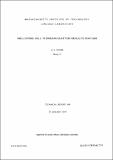Millstone Hill Thomson Scatter Results for 1968
Author(s)
Evans, J. V.
DownloadTR_499.pdf (2.393Mb)
Metadata
Show full item recordAbstract
This report summarizes the results for the electron density distribution, electron and ion temperatures in the F-region obtained during 1968 using the Millstone Hill (42.6°N, 71.5°W) Thomson (incoherent) scatter radar system. These data, for the height interval approximately 200 to 800 km, were gathered over 24-hour observing periods, roughly twice per calendar month. The time required to obtain a complete electron density and temperature profile over this height interval was usuaIly 30 minutes.
During 1968 the apparatus employed to measure the frequency spectrum of the reflected signals vs altitude, which in turn yields the estimates of the electron and ion temperatures, was rebuilt permitting the measurements at all altitudes to be made in real time, and with greater accuracy than heretofore. In addition, the new spectrum analyzer permitted the first measurements at Millstone Hill of the vertical drift of the plasma. These results, which are difficult to condense into summary form, are not included in the report.
The density and temperature results show that the separate clear patterns of summer and winter diurnal behavior, recognized at sunspot minimum, can still be discerned at sunspot maximum on all but very disturbed days. A number of disturbance patterns observed previously were again detected in 1968, albeit on fewer occasions than in 1967. Apparently, by chance, the days selected for observation in 1968 contained fewer instances of magnetic disturbance than in 1967.
The average heat flux from the magnetosphere has been investigated. While there appears to be a clear dependence on solar flux (as defined by the 10.7-cm radio emission), there remains a summer-to-winter variation of 5 to 7 that cannot be easily explained.
Date issued
1973-01-23Publisher
Haystack Observatory
Series/Report no.
Millstone Technical Reports;499